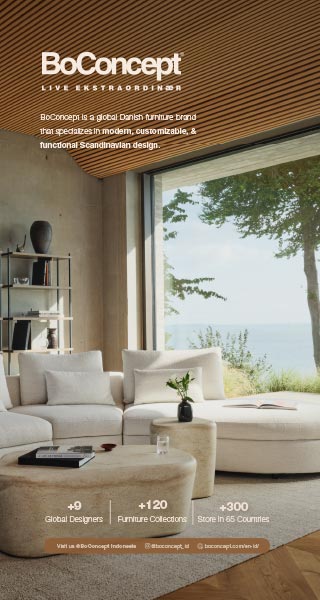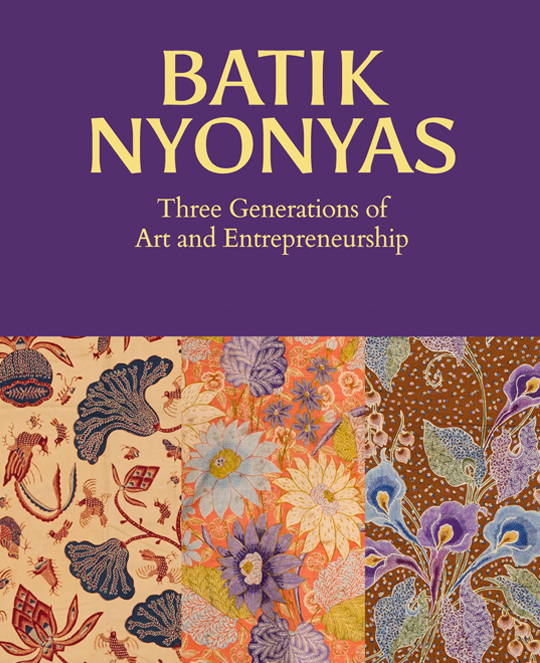
BATIK NYONYAS: THREE GENERATIONS OF ART AND ENTREPRENEURSHIP
Published by Sugar & Cream, Tuesday 22 October 2024
Images courtesy of Peranakan Museum
Family, Art, and Entrepreneurship
Family, art, and entrepreneurship converge in the Peranakan Museum’s latest exhibition, Batik Nyonyas: Three Generations of Art and Entrepreneurship, which opens to the public this Friday, 11 October 2024. The exhibition charts the lives, works, and careers of three visionary Peranakan women from the port city of Pekalongan, Indonesia — Nyonya Oeij Soen King, her daughter-in-law Nyonya Oeij Kok Sing, and her granddaughter Jane Hendromartono – revealing how each became a batik master in her own right, and how they responded to the rapid political, cultural, and economic changes of their times to run a business that produced great art.
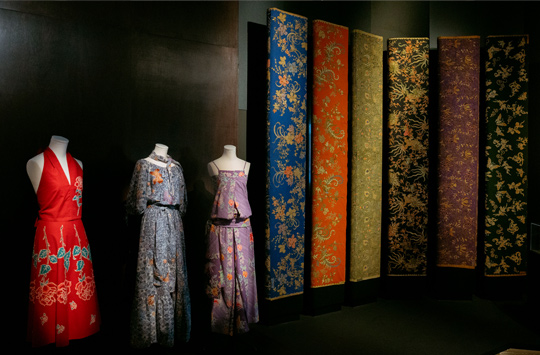
Their story unfolds through about 200 objects, including 60 pieces from the National Collection of Oeij family batiks produced between the 1890s and 1980s on display. The exhibition honours three major gifts to the museum from Ika, Melia, and Inge Hendromartono; the family of Mr. and Mrs Lee Kip Lee; and Mr. Agam Riadi. Through these works, visitors are invited to experience the artistic legacy of batik in an intimate, complex, and tangible way.
Mr Clement Onn, Director of ACM and the Peranakan Museum, says, “Batik Nyonyas: Three Generations of Art and Entrepreneurship is the first exhibition at Peranakan Museum to focus exclusively on a unique lineage of batik makers, allowing us to explore new perspectives on the past through the examination of microhistories. We are grateful for the generosity of our donors, whose contributions to the museum have been instrumental in illuminating the cultural, social, and political influences that shaped batik through a deeply personal lens. We particularly thank the Hendromartono family for carefully preserving these batiks over many years. With this exhibition, we hope that visitors are inspired to reflect on the ingenuity and perseverance of the three batik makers, as expressed through their art and their business.”
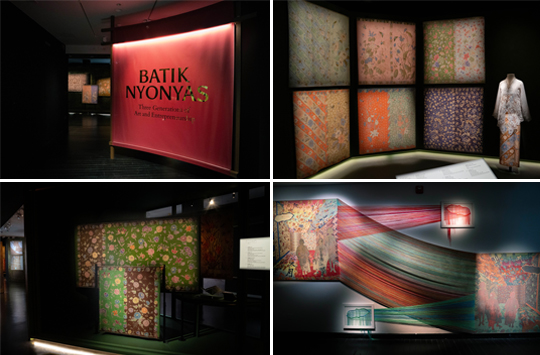
Nyonya Oeij Soen King (1871–1950), a master of natural dyes who innovated within established styles
Nyonya Oeij Soen King was one of several women who fronted batik businesses in Pekalongan in the 1890s, just as it was emerging as Java’s leading batik-making centre. In an increasingly competitive industry shaken up by the introduction of block-printed batiks, Nyonya Oeij was a creative entrepreneur who produced finely drawn batiks in an individualistic style. She worked out of her home workshop for about 25 years, until 1925.
Batik makers like Nyoyna Oeij catered to diverse markets across the region. The work on the left infuses classic Javanese geometric patterns and design compositions with elements from other cultures, as well as new designs and motifs, such as a buketan (bouquet) and kembang teratai (flowering lotus) pattern.
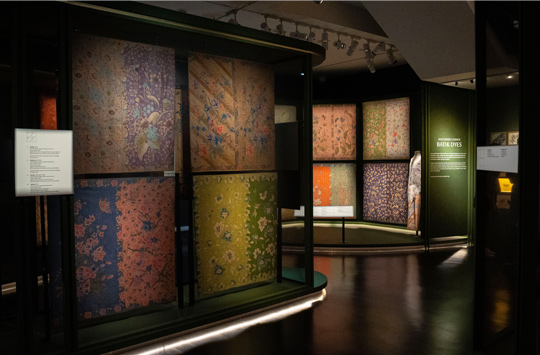
Unlike machine-made prints, which were faster to produce, Nyonya Oeij’s batiks feature meticulously hand-drawn designs on white backgrounds, laboriously coloured using only natural dyes. She avoided repetition through an asymmetrical and irregular interplay of colours, motifs, and filler patterns (isen), improvising within established frameworks to achieve visually complex designs. Her batiks were made in small quantities for select clients, and her artistry and virtuosity survive today through only 18 works.
Nyonya Oeij Kok Sing (1895–1966), a master of colour who reimagined batik in unconventional hues
The story continues with Nyonya Oeij Kok Sing, who was running the family workshop by 1929. During this period, fast-dyeing European synthetic dyes expanded the range of tones, leading to a surge in production and creative experimentation. Rising demand for fashionable batik sarongs and kebayas, as well as loosening social restrictions on women, led to the widespread commercialisation of the batik industry.

Presented by Som Santoso
Nyonya Oeij thrived within this competitive landscape. Embodying the new spirit of experimentation that characterised Pekalongan batik in the 1930s, she produced clothes in mind-bending combinations of colours and patterns. She was soon recognised as one of the top batik makers in Pekalongan. Notably, she was the only Indonesian artist who signed and stamped her batiks with dates, suggesting that she considered batik to be an important art form.
Jane Hendromartono (1924–1988), an artist of many names who adapted to challenging social conditions
Jane Hendromartono was the third generation of the Oeij family, one of six siblings who continued her mother’s legacy. She took over the family business in the 1940s during a period of great turmoil and explored a remarkable range of styles over a fifty-year career.
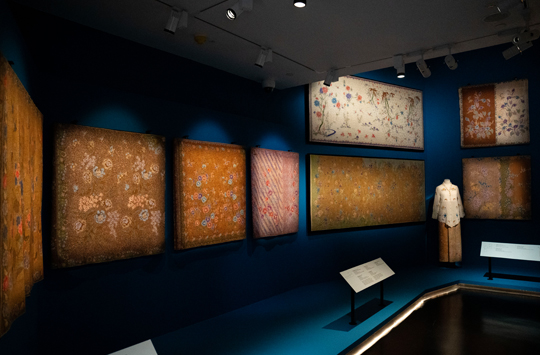
Jane displayed a remarkable knack for responding to market forces: in the 1950s, she created innovative interpretations of the batiks in the viral Kudus style. She was quick to respond to the national Batik Indonesia style, producing modern batiks for fairs and official events, which found ready buyers among the elite. In the 1970s she moved into the realm of high fashion, collaborating with top fashion designers to develop Indonesian haute couture.
Jane also sought ways to meet the rising demand for batik in foreign markets, from reimagining her mother and grandmother’s patterns to cater to the revival of traditional batik to combining hand-drawn techniques with block-printing to streamline the production process. As a result, she established a successful export business by the 1980s that offered a diverse range of textiles to overseas buyers.
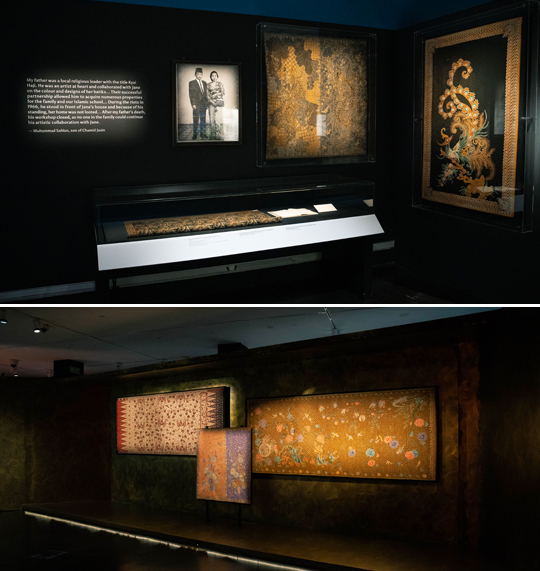
Jane closed her workshop in response to the increasingly fraught social and political landscape of the 1960s, collaborating instead with other workshop operators to keep her business afloat. Her partnership with Chamid Jasin (1927–1981) went beyond a business partnership. A close friend of the family, she depended on him to navigate difficult circumstances: he protected her home during riots and suggested Jane’s new Indonesian name, Hendromartono, which she incorporated into her branding from 1967.
Contemporary expressions of batik
The exhibition ends by exploring the legacy of female batik makers in Indonesia, focusing on works from the 1980s to today. This section showcases how contemporary artists, much like the Oeij family, have kept this artform alive, while also finding innovative ways of designing batik.
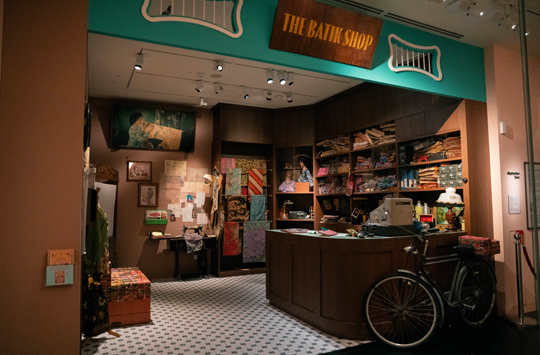
Batik Nyonyas is complemented by a contemporary art commission by Aiko Tezuka, whose works are based on the unraveling of woven fabric. The artwork explores the complex identities of the three women in the exhibition by considering home, art, and the passage of time. Against a three-dimensional backdrop of batik designs by the three women, Tezuka exposes the reverse side of the textile, displaying two sides of the same design in contrasting colours.
Personalise your batik style
Visitors will discover in-gallery interactive stations that include tactile activities on the batik-making process. They can discover their personal batik style in a fun mobile quiz, with the result revealed in The Batik Shop, a space in the Level 3 Exploration Zone dressed up to emulate shops in Singapore and Indonesia. After completing their experience, visitors can also redeem a specially illustrated bookmark from the Visitor Services Counter on Level 1 to take home as a souvenir.
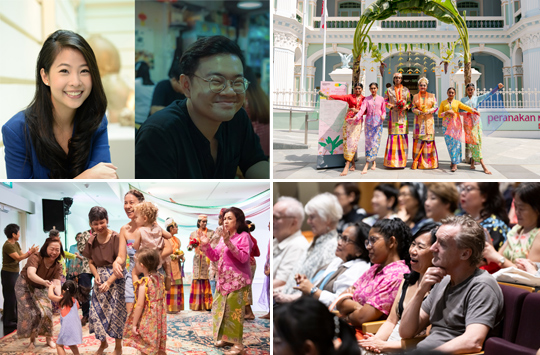
Batik Nyonyas – Curator Tours | Community Voices with the Peranakan Indians | Weekend Festival | Talks
The exhibition is accompanied by a catalogue of essays exploring the lives and works of the three women. Visitors interested in delving deeper into the world of batik should keep an eye out for drop-in performances and craft activities as part of the exhibition’s Weekend Festival and Batik Stories, as well as monthly curator tours and a series of talks.
Batik Nyonyas: Three Generations of Art and Entrepreneurship runs from 11 October 2024 to 31 August 2025 at the Special Exhibition Gallery at Peranakan Museum, admission charges apply. For more information, please visit https://www.nhb.gov.sg/peranakanmuseum/.
 4.01K
22/12/2025
4.01K
22/12/2025
TUMI HADIRKAN “GIFT JOY” UNTUK MUSIM LIBURAN
Temukan hadiah akhir tahun yang berkesan melalui koleksi TUMI, menghadirkan desain elegan dan craftmanship yang bertahan lama.
read more 1.74K
22/12/2025
1.74K
22/12/2025
YOSAFAT DWI KURNIAWAN — “TIME DILATION”
Yosafat Dwi Kurniawan’s “Time Dilation”: celebrating 15 years of craft through a modern reimagining of couture heritage.
read more 10.97K
03/12/2025
10.97K
03/12/2025
LIVING DIVANI ILLUMINATES THE FESTIVE SEASON IN SHADES OF DEEP RED AND LUMINOUS SILVER
Living Divani illuminates the festive season in shades of deep red and luminous silver, reimagining its iconic designs with festive radiance.”
read more 10.66K
26/11/2025
10.66K
26/11/2025
MOROSO AT ARTVERONA 2025: DESIGN AS DIALOGUE
Design as language – Moroso’s presence at the heart of ArtVerona’s 20th Edition
read more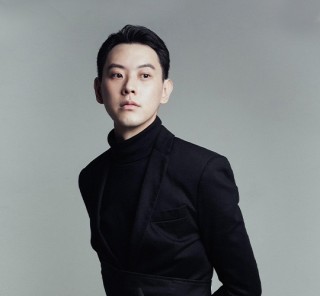 81.48K
10/01/2025
81.48K
10/01/2025
W RESIDENCE IN SOUTH JAKARTA BY MICHAEL CHANDRA
Michael Chandra, founder of MNCO Studio Design has created the W Residence with an aesthetically pleasing, practical, and pleasant home from all...
read more 44.44K
11/07/2025
44.44K
11/07/2025
PELUNCURAN PERDANA LEGANO HOME MENGGANDENG AGAM RIADI DI ST REGIS RESIDENCE JAKARTA
Peluncuran perdana LEGANO HOME menggandeng Agam Riadi di St. Regis Residence Jakarta: menyatukan kemewahan dan jiwa dalam sebuah ruang.
read more





